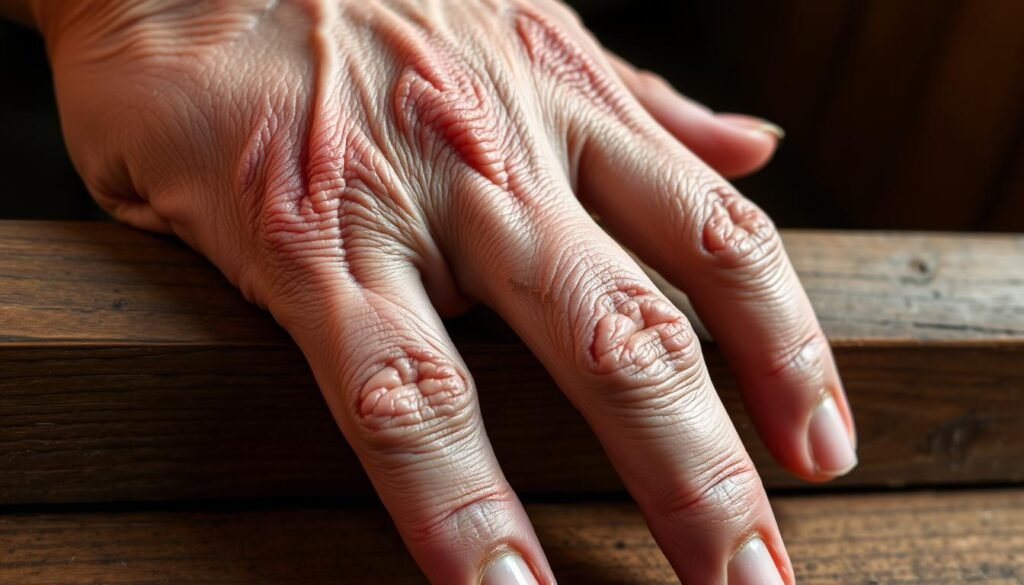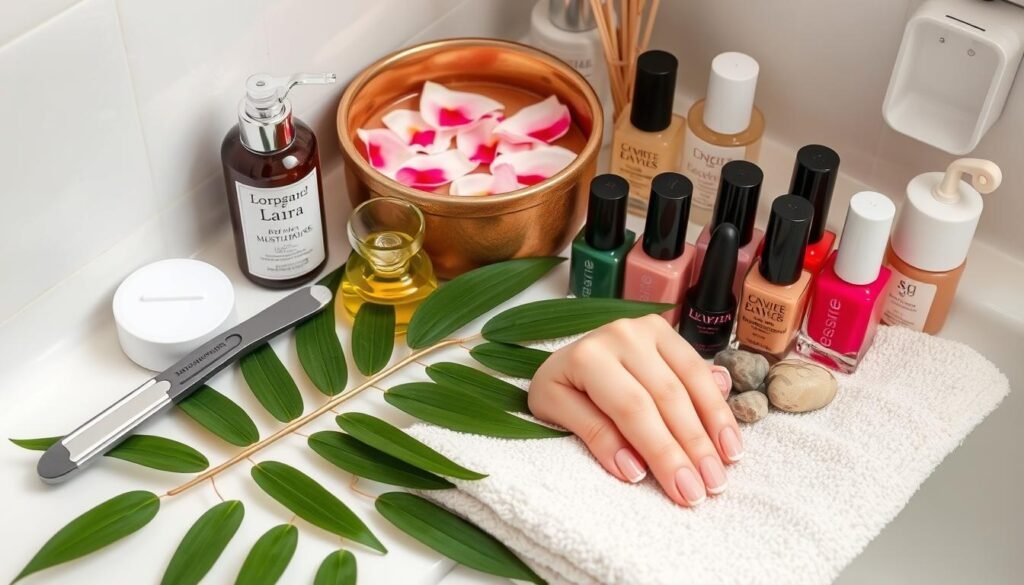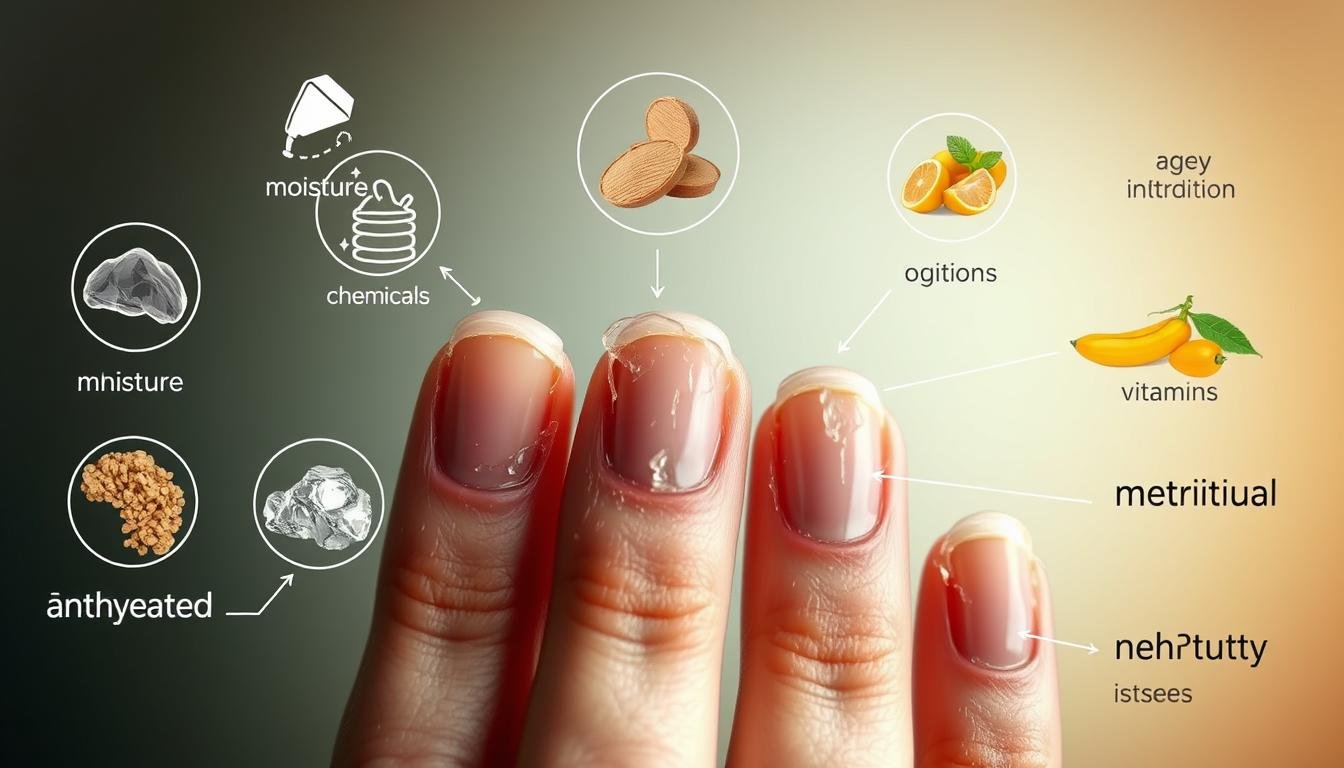Did you know nearly 20% of people battle brittle nails? This condition, called onychorrhexis in medical terms, is more common than you might think. It affects people of all ages, causing both discomfort and annoyance. Understanding what causes brittle nails is key to having healthy nails.
Brittle nails often split, peel, or break. It’s important to look at what leads to weaker nails. Things like your genes, the environment, and not getting enough nutrients all play a part. We’re going to explore why brittle nails happen and how you can improve your nail health.
Key Takeaways
- One in five people experiences brittle nails, making it a widespread issue.
- Conditions like onychorrhexis can lead to discomfort and ongoing nail problems.
- Genetic and environmental factors significantly contribute to brittle nails.
- Nutritional deficiencies are crucial in determining overall nail health.
- Proper understanding can guide prevention and treatment strategies.
- Hydration plays a key role in maintaining strong and healthy nails.
Understanding Brittle Nails
Brittle nails are often seen as weak and not very healthy. They may look dull, show ridges, or break easily. It’s vital to spot these signs early. This way, you can understand what might be causing the problem.
Even though brittle nails are strong against physical harm, they can shake one’s self-esteem. They might hint at deeper health issues. If you keep having this issue, it’s wise to check how strong your nails are overall. You might need some advice on making them healthier.
| Characteristic | Brittle Nails | Normal Nails |
|---|---|---|
| Appearance | Dull, lackluster | Shiny, smooth |
| Ridges | Prominent | Smooth |
| Split easily | Yes | No |
| Overall Strength | Weak | Strong |
Knowing how brittle nails differ from healthy ones is important. This knowledge helps you watch for changes in nail health. You can decide if you need to improve your nail’s strength.
What Are the Symptoms of Brittle Nails?
The symptoms of brittle nails show up as peeling, cracking, and splitting. These are signs that your nails are not strong. People with these issues might see their nails looking odd. They might notice shapes that aren’t normal or surfaces that aren’t smooth.
When talking about how brittle nails appear:
- Visible cracks or splits can be seen on the nail
- The layers peel often and can flake off without effort
- The texture of the nails can feel rough when you touch them
Brittle nails symptoms are a warning to not ignore the problem. If you don’t pay attention, it could get worse. If your nails break easily, it’s important to look at your health too. Sometimes, other health issues can make the nail problem bigger. For tips on dealing with brittle nails, check out this resource.
Common Causes Brittle Nails
Brittle nails are caused by both genetics and the environment. Knowing these causes helps keep your nails healthy.
Genetic Factors
Genes can make nails brittle. Some people inherit nail problems that affect their strength. Family history clues us into our nail health.
Environmental Exposures
Our environment affects our nails too. Cold weather, heavy cleaning, and chemicals wear them down. Water and harsh cleaners remove nails’ natural oils.
Extreme weather also harms them. Knowing these facts helps us protect our nails better.
Nutritional Deficiencies Linked to Nail Health
Eating right is key to having strong nails. A diet full of vitamins and minerals helps stop nails from getting weak. When we don’t get enough nutrients, our nails can become brittle and look unhealthy.
Vitamin Deficiency: Key Vitamins for Strong Nails
Vitamins are very important for nail health. Not getting enough of certain vitamins, like:
- Biotin: This vitamin helps make keratin, which strengthens nails.
- Vitamin A: It is important for growing and fixing nails.
- Vitamin C: This vitamin is needed for making collagen, keeping nails strong.
- Vitamin E: Keeps nails moist.
Add foods high in these vitamins to your meals to fight off vitamin shortages. This leads to stronger nails.
Importance of Minerals for Nail Strength
Minerals like zinc and iron are also key for healthy nails. Not having enough can cause:
- Weak nails: Nails break and split more easily.
- Discoloration: Nails might look less healthy.
Eating meats, legumes, nuts, and green veggies improves your mineral intake. This keeps your nails strong and tough.
| Nutrient | Benefits for Nail Health | Food Sources |
|---|---|---|
| Biotin | Strengthens nails | Eggs, nuts, whole grains |
| Vitamin A | Aids growth and repair | Carrots, sweet potatoes, spinach |
| Vitamin C | Supports collagen production | Citrus fruits, strawberries, bell peppers |
| Vitamin E | Maintains moisture | Nuts, seeds, green leafy vegetables |
| Zinc | Promotes healing | Meat, shellfish, legumes |
| Iron | Prevents brittleness | Red meat, beans, spinach |
The Role of Hydration in Nail Health
Staying hydrated is key for keeping nails strong. Nails that get enough water are less likely to break, which fights off the common causes brittle nails. Drinking plenty of water is good for your whole body, including your nails.
Using moisturizers made just for nails can help too. These products seal in moisture, protecting nails from things that can harm them. If you use them regularly, your nails will look and feel better.
Eating foods full of water is another smart move. Great options are:
- Watermelon
- Cucumbers
- Oranges
- Strawberries
- Bell peppers
These foods hydrate and bring vitamins and minerals that nails need to be healthy. For strong nails, it’s crucial to keep them hydrated from the inside out and the outside in.
Impact of Aging on Nail Condition
As we get older, our nails change. Many people notice their nails grow slower. This leads to weaker nails. There’s a drop in key nutrients that keeps our nails healthy.
Nails become more brittle and fragile with age. They break and split more easily. Hormones change as we age, making nails weaker. Poor circulation, a common issue in older adults, also affects nail strength.

It’s important to understand how aging affects our nails. Knowing about these changes can help us take better care of our nails. This means a better quality of life as we grow older.
| Age Group | Nail Growth Rate (mm/month) | Common Nail Issues |
|---|---|---|
| 20-30 | 3.5-4.5 | Minor brittleness |
| 30-50 | 2.5-3.5 | Increased brittleness, color changes |
| 50+ | 1.5-2.5 | Significant brittleness, ridges, slow growth |
Caring for our nails gets more important as we age. Eating well, staying hydrated, and using products that add moisture are key. These steps help fight the effects of aging and keep nails strong.
Medical Conditions That Contribute to Weak Nails
Brittle nails can be a sign of different medical issues. It’s important to know when to seek help from a doctor. Problems like thyroid disorders and certain skin conditions can make nails weak.
Thyroid Disorders
Thyroid issues, especially hypothyroidism, can make nails weak. An underactive thyroid slows nail growth, leading to brittle nails. They may become dry, thin, and split easily. Checking thyroid levels and treating them can help make nails stronger. This shows how connected medical conditions are to nail health.
Skin Conditions Affecting Nail Strength
Some skin conditions can also weaken nails. Psoriasis and eczema are common problems that lead to weak nails. They cause skin irritation, nail pitting, and changes in color. Treating these skin issues can help nails become stronger and look better.
Knowing about these medical issues is key to getting the right treatment. Managing thyroid and skin problems can improve nail health. For more information on how these conditions affect nails, check out this helpful article.
| Medical Condition | Effect on Nails | Treatment Approaches |
|---|---|---|
| Thyroid Disorders | Weak, slow-growing nails | Medication to normalize thyroid hormones |
| Psoriasis | Pitting and discoloration | Topical treatments and systemic medications |
| Eczema | Dryness and brittleness | Moisturizers and anti-inflammatory creams |
Effects of Chemical Exposure on Nails
Common household items can greatly harm nail health. Many don’t know that products like cleaners, nail polish removers, and some cosmetics have harsh chemicals. These can make nails brittle.
With time, these products can take away moisture from the nails. This makes them dry and weak.
To keep nails healthy, it’s crucial to reduce chemical exposure. Let’s look at some tips to protect your nails:
- Select milder cleaning products that are free from strong chemicals.
- Use gloves when handling household cleaners to prevent direct contact with the nails.
- Opt for acetone-free nail polish removers, which are less drying to the nails.
- Ensure adequate ventilation when using any chemical products to minimize inhaling fumes.
By following these tips, you can keep your nails strong. Being aware and taking action against chemical exposure helps build better nail care habits.
Preventive Nail Care Tips
Taking care of your nails is important. It helps keep them strong and resilient. We’ll look at two key ways to care for your nails: keeping them moisturized and following a good nail care routine.
Maintaining Moisture and Hydration
Moisture is crucial for strong nails and cuticles. Use a moisturizing cream or oil regularly. Choose products made for nails with nourishing ingredients. Here’s what to do:
- Apply moisturizer after washing hands.
- Use natural oils like jojoba or almond for hydration.
- Consider wearing gloves when engaging in activities that expose hands to harsh chemicals or water.
Proper Nail Care Routine
A good nail care routine is essential for healthy nails. It should include gentle filing and trimming. Avoid bad habits like nail biting. Here are the steps to follow:
- File nails to maintain shape without causing damage.
- Trim nails regularly to prevent excessive length.
- Avoid chemicals that can weaken nails, focusing instead on mild soaps and moisturizers.
For more tips on nail hygiene and care, check out this guide on preventive nail care tips.

Brittle Nail Treatment Options
Brittle nails need special care to get better. There are many choices for treatment that fit everyone’s needs. One well-liked choice is over-the-counter strengthening polishes. These polishes have proteins and moisturizers to make weak nails stronger.
Eating differently and taking supplements is another way to help. Adding vitamins and minerals to your diet is key. Eat more biotin, zinc, and omega-3 rich foods to improve nail health. It’s a good idea to talk to a doctor about supplements, too.
If your nail problems are serious, there’s help at salons. You can get keratin treatments or nail wraps for quick improvement. If you have an ongoing condition affecting your nails, see a dermatologist. They can recommend the best treatment for brittle nails.
Conclusion
Looking into why nails break easily, we find several reasons. These include not getting enough nutrients, being in harsh environments, and health issues. It’s crucial to take good care of our nails and make smart lifestyle choices. Following nail care tips and eating right can make a big difference in keeping nails strong.
Taking care of our nails regularly helps prevent them from getting brittle. It also makes them stronger and more resistant to damage. It’s important to look out for any health problems that could affect your nails. Staying on top of these issues is a key part of keeping your nails healthy.
With the right effort and choices, anyone can achieve healthy nails. Paying attention to what we eat and how we care for our nails plays a big role. This way, we can lower the chance of having brittle nails.



